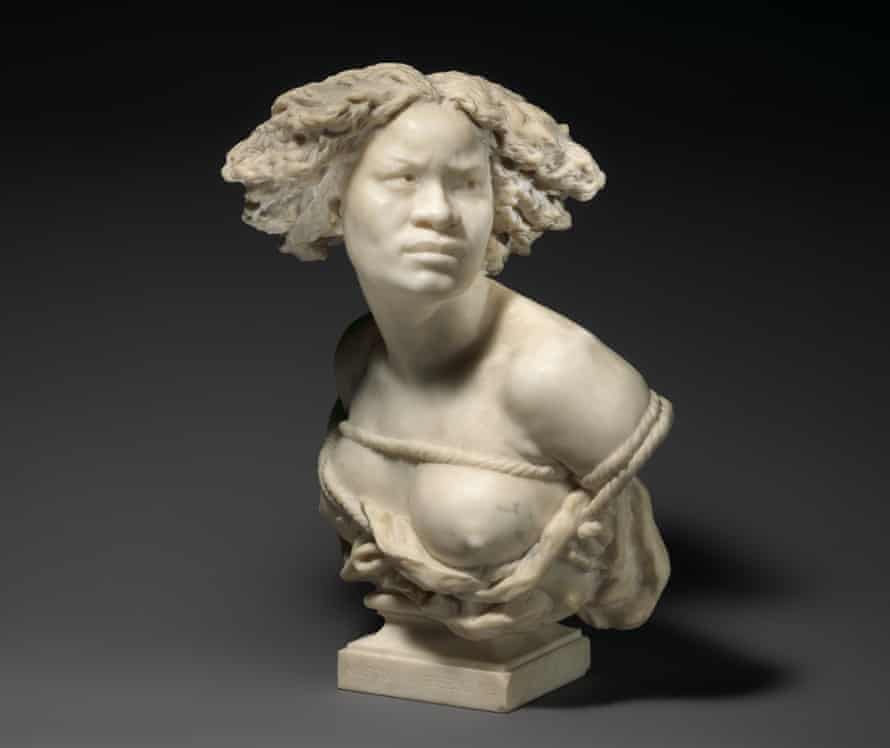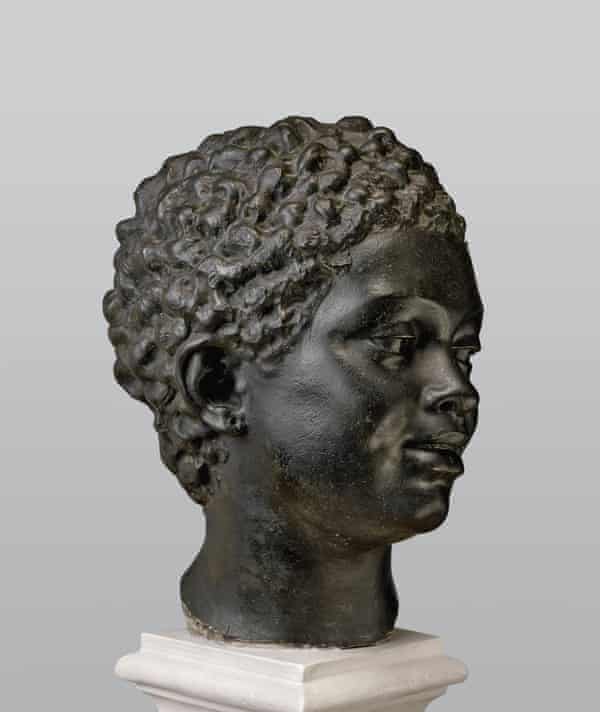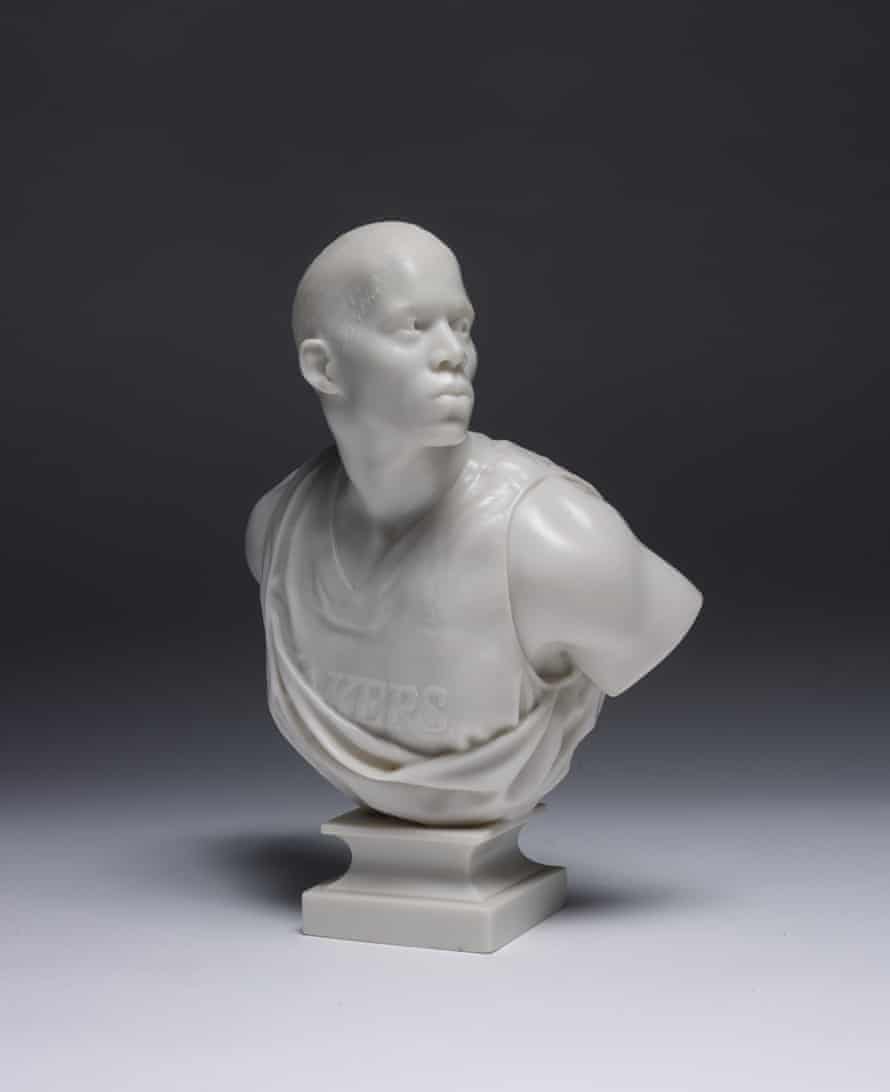
Installation view of Fictions of Emancipation: Carpeaux Recast.
Photograph: Photo by Anna-Marie Kellen, Courtesy of The Met
In a new exhibition, the popularity of antislavery art is revisited with a critical eye on what is being shown and why it’s being celebrated
Walker Mimms
In a new exhibition, the popularity of antislavery art is revisited with a critical eye on what is being shown and why it’s being celebrated
Walker Mimms
THE GUARDIAN
Tue 7 Jun 2022
Museum exhibitions are traditionally about objects. But in a provocatively commentated show of Black portraits from the 18th and 19th centuries, the Met confronts itself.
Fictions of Emancipation: Carpeaux Recast centers on Why Born Enslaved!, the bust Jean-Baptiste Carpeaux modelled in 1868 and produced in popular editions thereafter. Life-size, she is bound at the chest with rope, glowering upwards in knowledge and pain – a captive with no doubts of the crime she’s been dealt.

‘It’s so joyful and full of promise’: a modernism exhibition aims for hope
The Met already owned Carpeaux’s terracotta version of the famous work. Then a rare marble (one of two from his studio) went on sale in 2018. “When the opportunity to acquire this bust came up,” Elyse Nelson, the conceiver and co-curator of the show, told me, “we acquired it with the idea that this could be the lynchpin for an exhibition.”
“Sculpture requires patronage, requires wealthy patrons, so is often associated with the state,” Nelson explained. That state, the court of Napoleon III, was very proud of the emancipation decree from back in 1846, a generation before America’s. Carpeaux’s work offered a belated congratulations to France. The emperor was among its first buyers.
But when art is tied to regimes — especially regimes as grabby as the Second Empire – it has trouble gaining our trust. There was something unclean about the Met’s acquisition: by purchasing an enslaved woman, the show’s catalog asks, “can we be other than complicit in the aestheticization of slavery?”
In this spirit, the show interrogates Carpeaux across his early sketches of the bust, his marble, his earlier versions, and his renderings of a larger public work related to her. It must be the fullest examination ever staged of his iconic sculpture.
For the catalog Wendy S Walters, a professor of non-fiction at Columbia and Nelson’s co-curator, explores the work as a record of subjection, even fetishization. “We have historically understood enslavement,” Walters explained to me, “to think that the sexual component of enslavement was separate from the work component.” They were not.
Museum exhibitions are traditionally about objects. But in a provocatively commentated show of Black portraits from the 18th and 19th centuries, the Met confronts itself.
Fictions of Emancipation: Carpeaux Recast centers on Why Born Enslaved!, the bust Jean-Baptiste Carpeaux modelled in 1868 and produced in popular editions thereafter. Life-size, she is bound at the chest with rope, glowering upwards in knowledge and pain – a captive with no doubts of the crime she’s been dealt.

‘It’s so joyful and full of promise’: a modernism exhibition aims for hope
The Met already owned Carpeaux’s terracotta version of the famous work. Then a rare marble (one of two from his studio) went on sale in 2018. “When the opportunity to acquire this bust came up,” Elyse Nelson, the conceiver and co-curator of the show, told me, “we acquired it with the idea that this could be the lynchpin for an exhibition.”
“Sculpture requires patronage, requires wealthy patrons, so is often associated with the state,” Nelson explained. That state, the court of Napoleon III, was very proud of the emancipation decree from back in 1846, a generation before America’s. Carpeaux’s work offered a belated congratulations to France. The emperor was among its first buyers.
But when art is tied to regimes — especially regimes as grabby as the Second Empire – it has trouble gaining our trust. There was something unclean about the Met’s acquisition: by purchasing an enslaved woman, the show’s catalog asks, “can we be other than complicit in the aestheticization of slavery?”
In this spirit, the show interrogates Carpeaux across his early sketches of the bust, his marble, his earlier versions, and his renderings of a larger public work related to her. It must be the fullest examination ever staged of his iconic sculpture.
For the catalog Wendy S Walters, a professor of non-fiction at Columbia and Nelson’s co-curator, explores the work as a record of subjection, even fetishization. “We have historically understood enslavement,” Walters explained to me, “to think that the sexual component of enslavement was separate from the work component.” They were not.

Jean-Baptiste Carpeaux (French, 1827–1875) Why Born Enslaved!, modeled 1868, carved 1873.
Photograph: Paul Lachenauer/The Metropolitan Museum of Art, Purchase, Lila Acheson Wallace, Wrightsman Fellows, and Iris and B. Gerald Cantor Foundation
Walters argues that Carpeaux revisits that sexual component a little too readily: the hyperrealism where rope meets breast, the artist’s alleged aggression toward women, his commodification of a slave’s likeness for financial gain and political favor.
Viewers will leave either outraged by such politicization of art or equipped with a more nuanced understanding of the touchy era following abolition, a time when European heads of state made grand gestures toward equality while they plotted the Scramble for Africa.
Carpeaux’s contemporaries appear and give him context. Familiar works by Charles Cordier field unsparing questions about the white gaze. Once a gem of the collection, the Black man of Jean-Leon Gérome’s Bashi Bazouk (1868-69) still adorns the cover of the Met’s official guidebook, but now it is scrutinized “through the prism of European imperialism”.
One of the show’s virtues is to reach back before Carpeaux, to the golden era of protest when his abolitionist vocabulary was first being forged. One display is devoted to Josiah Wedgwood, the English potter whose medallion from 1787 took off like wildfire among activists of the time. No bigger than a thumbprint, it shows a Black man chained and begging for our sympathy. Here he is reproduced on a glass cologne bottle, on a pearlware jug, and on a gilded seal fob modified to show a female slave.
Though Wedgwood’s intentions were good and his timing ingenious, such finery smacks of the black Instagram square, the corporate pledge to “do better”, the pint of Juneteenth ice cream.
The most illuminating guest is Jean-Antoine Houdon, Carpeaux’s forebear in marble. Locals have long admired Houdon’s Bather (1782) in the Met’s sun-drenched court of European sculpture. Braced for a splash, the bather is lovely – the arch of her outstretched foot fixed nimbly on a stone, a detail both structural and emotive.
Walters argues that Carpeaux revisits that sexual component a little too readily: the hyperrealism where rope meets breast, the artist’s alleged aggression toward women, his commodification of a slave’s likeness for financial gain and political favor.
Viewers will leave either outraged by such politicization of art or equipped with a more nuanced understanding of the touchy era following abolition, a time when European heads of state made grand gestures toward equality while they plotted the Scramble for Africa.
Carpeaux’s contemporaries appear and give him context. Familiar works by Charles Cordier field unsparing questions about the white gaze. Once a gem of the collection, the Black man of Jean-Leon Gérome’s Bashi Bazouk (1868-69) still adorns the cover of the Met’s official guidebook, but now it is scrutinized “through the prism of European imperialism”.
One of the show’s virtues is to reach back before Carpeaux, to the golden era of protest when his abolitionist vocabulary was first being forged. One display is devoted to Josiah Wedgwood, the English potter whose medallion from 1787 took off like wildfire among activists of the time. No bigger than a thumbprint, it shows a Black man chained and begging for our sympathy. Here he is reproduced on a glass cologne bottle, on a pearlware jug, and on a gilded seal fob modified to show a female slave.
Though Wedgwood’s intentions were good and his timing ingenious, such finery smacks of the black Instagram square, the corporate pledge to “do better”, the pint of Juneteenth ice cream.
The most illuminating guest is Jean-Antoine Houdon, Carpeaux’s forebear in marble. Locals have long admired Houdon’s Bather (1782) in the Met’s sun-drenched court of European sculpture. Braced for a splash, the bather is lovely – the arch of her outstretched foot fixed nimbly on a stone, a detail both structural and emotive.

Jean-Antoine Houdon - Head of a Woman, circa 1781.
Photograph: Musée Municipal de Soissons / Bertrand Coutellier
It turns out she didn’t wash alone. The bather was commissioned for a fountain in the forty-five-acre pleasure garden (now the Parc Monceau) of the King’s cousin, the duc d’Orleans. Above her originally stood a Black woman carved in lead, a servant who pumped water through a ewer onto the pure white back of her stone mistress.
Though the servile half of the fountain disappeared during the Revolution, a plaster of her head appears on loan from Soissons. Far from Houdon’s famous realism (see his exquisite Ben Franklin in the American wing), this head depicts a simplified, obsequious, very unfortunate, smiling mammy.
Worse, when France freed her slaves the first time, in 1794, Houdon converted his slave’s likeness into terracotta, scrawled an abolitionist caption into her base, and mass-produced her as a souvenir of emancipation. The Met have brought out their copy of this miniature for the show.
Here is expert curation: the plaster slave, the clay freedwoman, the implied connection to the marble mistress across the wing. “I think this project changed me as an art historian,” Nelson said of such timebombs. “I think that this is just the beginning of a conversation, and that a larger conversation could follow.”
If the parable of Houdon teaches anything, it’s how greasily the feudal values of the ancien régime could masquerade as liberalism. These masqueraded in artist and patron alike: having installed Houdon’s “happy slave” fountain in his wonderland, the duc d’Orleans, one of the richest men in France, renounced his title when revolution arrived and rebranded himself “Philippe Egalité”. (The guillotine got him anyway.)
The curators believe Houdon’s cheap intentions with his smiling slave “served as precedents” for Carpeaux 90 years later. But Why Born Enslaved! is not so easily reduced – not quite.
Yes, Carpeaux’s patrons, like Houdon’s opportunist duc, were the worst kinds of virtue signalers. While Napoleon III sent troops to steal Mexico from behind the back of a war-torn America (a Union general had to shoo them out), his empress used her bronze of Why Born Enslaved! to broadcast republican sentiment back home.
And yes, Carpeaux borrowed from his own racialized fountain, his globe allegory in the Luxembourg Gardens in Paris (1874). Now anonymous, the sitter for Why Born Enslaved! was visibly the same woman who modelled his “Africa” in that monumental public work. The chain around Africa’s ankle might well be construed as a degrading and irrelevant icon. “That was very common,: an emancipated figure, even decades after abolition, would still be carrying the vestiges of their captivity,” Walters explained.
It turns out she didn’t wash alone. The bather was commissioned for a fountain in the forty-five-acre pleasure garden (now the Parc Monceau) of the King’s cousin, the duc d’Orleans. Above her originally stood a Black woman carved in lead, a servant who pumped water through a ewer onto the pure white back of her stone mistress.
Though the servile half of the fountain disappeared during the Revolution, a plaster of her head appears on loan from Soissons. Far from Houdon’s famous realism (see his exquisite Ben Franklin in the American wing), this head depicts a simplified, obsequious, very unfortunate, smiling mammy.
Worse, when France freed her slaves the first time, in 1794, Houdon converted his slave’s likeness into terracotta, scrawled an abolitionist caption into her base, and mass-produced her as a souvenir of emancipation. The Met have brought out their copy of this miniature for the show.
Here is expert curation: the plaster slave, the clay freedwoman, the implied connection to the marble mistress across the wing. “I think this project changed me as an art historian,” Nelson said of such timebombs. “I think that this is just the beginning of a conversation, and that a larger conversation could follow.”
If the parable of Houdon teaches anything, it’s how greasily the feudal values of the ancien régime could masquerade as liberalism. These masqueraded in artist and patron alike: having installed Houdon’s “happy slave” fountain in his wonderland, the duc d’Orleans, one of the richest men in France, renounced his title when revolution arrived and rebranded himself “Philippe Egalité”. (The guillotine got him anyway.)
The curators believe Houdon’s cheap intentions with his smiling slave “served as precedents” for Carpeaux 90 years later. But Why Born Enslaved! is not so easily reduced – not quite.
Yes, Carpeaux’s patrons, like Houdon’s opportunist duc, were the worst kinds of virtue signalers. While Napoleon III sent troops to steal Mexico from behind the back of a war-torn America (a Union general had to shoo them out), his empress used her bronze of Why Born Enslaved! to broadcast republican sentiment back home.
And yes, Carpeaux borrowed from his own racialized fountain, his globe allegory in the Luxembourg Gardens in Paris (1874). Now anonymous, the sitter for Why Born Enslaved! was visibly the same woman who modelled his “Africa” in that monumental public work. The chain around Africa’s ankle might well be construed as a degrading and irrelevant icon. “That was very common,: an emancipated figure, even decades after abolition, would still be carrying the vestiges of their captivity,” Walters explained.

Kehinde Wiley (American, born 1977) After La Négresse, 1872,
2006 Photograph: Courtesy of the artist and Sean Kelly Gallery, NY
For context, Walters and Nelson include earlier “four continents” allegories in porcelain and on paper. For all its realism, Carpeaux’s fountain – and by extension his bust – derived from a time-worn menu of ethnic tropes that put Europa first.
But these facts cannot dim the absolute electricity of the woman’s gaze. Against her ropes she spins sharply to the left, and as you spin with her, encircling a back-to-back display of the terracotta and the later marble, you’ll detect from that early draft to the final one a faint sharpening of her brow — as if a wound that began in entreaty has hardened into reproach. Against the glib Wedgwood and the shameless Houdon, Carpeaux creates nothing less than a human.
Janet Jackson owned a reproduction, Beyoncé posed with one, and Kehinde Wiley depends on the sincerity of Carpeaux’s original for the strength of his own homage, which is wisely on display: a small bust critiquing exploitation in modern sports.
Carpeaux’s endurance, as this searching and feisty exhibition makes clear, can and should exist alongside the paternalizing traditions and the dirty money in spite of which his work took such vivid life.
“The figures themselves carry multiple valences,” Walters offered, “and if we allow them to carry multiple valences, then we’re really starting to think critically about what representation is, which to me seems to be the purview of a museum.”
Fictions of Emancipation: Carpeaux Recast is on display at the Metropolitan Museum of Art in New York until 5 March 2023
For context, Walters and Nelson include earlier “four continents” allegories in porcelain and on paper. For all its realism, Carpeaux’s fountain – and by extension his bust – derived from a time-worn menu of ethnic tropes that put Europa first.
But these facts cannot dim the absolute electricity of the woman’s gaze. Against her ropes she spins sharply to the left, and as you spin with her, encircling a back-to-back display of the terracotta and the later marble, you’ll detect from that early draft to the final one a faint sharpening of her brow — as if a wound that began in entreaty has hardened into reproach. Against the glib Wedgwood and the shameless Houdon, Carpeaux creates nothing less than a human.
Janet Jackson owned a reproduction, Beyoncé posed with one, and Kehinde Wiley depends on the sincerity of Carpeaux’s original for the strength of his own homage, which is wisely on display: a small bust critiquing exploitation in modern sports.
Carpeaux’s endurance, as this searching and feisty exhibition makes clear, can and should exist alongside the paternalizing traditions and the dirty money in spite of which his work took such vivid life.
“The figures themselves carry multiple valences,” Walters offered, “and if we allow them to carry multiple valences, then we’re really starting to think critically about what representation is, which to me seems to be the purview of a museum.”
Fictions of Emancipation: Carpeaux Recast is on display at the Metropolitan Museum of Art in New York until 5 March 2023
No comments:
Post a Comment